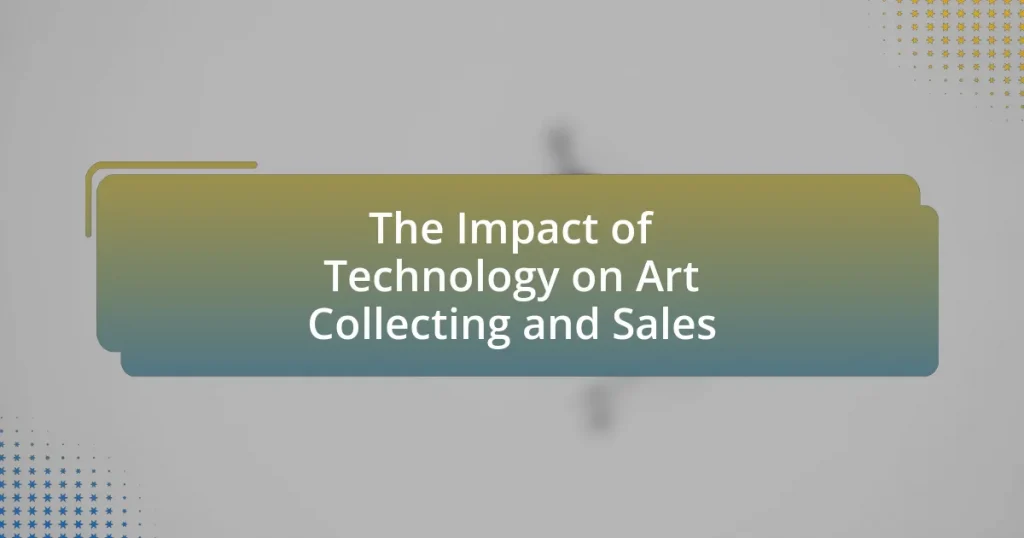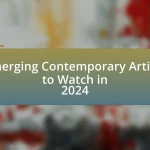The article examines the significant impact of technology on art collecting and sales, highlighting how advancements such as online marketplaces, blockchain, and augmented reality have transformed the landscape. It discusses the increased accessibility and transparency these technologies provide, allowing collectors to engage with a global market and verify the authenticity of artworks. Additionally, the article addresses the challenges posed by digital transactions, including issues of fraud and the lack of physical inspection, while emphasizing the importance of best practices for collectors in the digital age. Overall, it underscores the evolving dynamics of the art market driven by technological innovations.
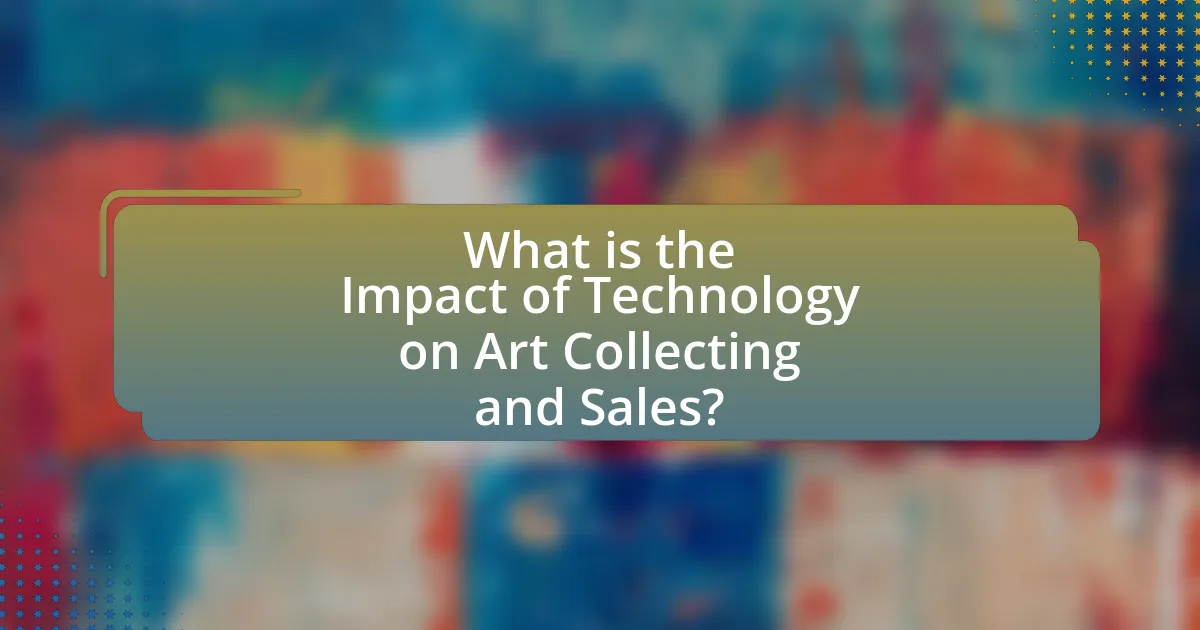
What is the Impact of Technology on Art Collecting and Sales?
Technology significantly transforms art collecting and sales by enhancing accessibility, streamlining transactions, and enabling new forms of art creation. Online platforms like Artsy and Saatchi Art allow collectors to browse and purchase artworks from global artists, breaking geographical barriers. Additionally, blockchain technology ensures provenance and authenticity, which is crucial in high-value transactions. According to a report by Hiscox, online art sales reached $12.4 billion in 2021, reflecting a 75% increase since 2019, indicating a growing trend towards digital marketplaces. Furthermore, virtual reality and augmented reality technologies provide immersive experiences for potential buyers, allowing them to visualize art in their own spaces before making a purchase.
How has technology transformed the art collecting landscape?
Technology has transformed the art collecting landscape by enabling greater accessibility, transparency, and efficiency in the buying and selling processes. Online platforms and marketplaces, such as Artsy and Saatchi Art, allow collectors to browse and purchase artworks from around the world, breaking geographical barriers that previously limited access to local galleries. Additionally, blockchain technology provides provenance tracking, ensuring authenticity and ownership history, which enhances trust in transactions. According to a report by Hiscox, online art sales reached $12.4 billion in 2021, reflecting a significant shift towards digital engagement in the art market. This digital transformation has democratized art collecting, allowing a broader audience to participate and invest in art.
What technological advancements have influenced art collecting?
Technological advancements such as online marketplaces, blockchain technology, and augmented reality have significantly influenced art collecting. Online marketplaces like Artsy and Saatchi Art have expanded access to a global audience, allowing collectors to discover and purchase art from anywhere. Blockchain technology enhances provenance tracking and authenticity verification, addressing concerns about forgery and ownership history. Augmented reality applications enable collectors to visualize artworks in their own spaces before making a purchase, improving decision-making. These advancements collectively reshape the art collecting landscape by increasing accessibility, ensuring authenticity, and enhancing the buying experience.
How do digital platforms change the way art is collected?
Digital platforms transform art collection by enabling broader access, facilitating online transactions, and fostering community engagement. These platforms allow collectors to discover and purchase artworks from global artists without geographical limitations, significantly expanding the market. For instance, online marketplaces like Artsy and Saatchi Art provide extensive catalogs and detailed artist profiles, making it easier for collectors to make informed decisions. Additionally, digital platforms often incorporate features such as virtual galleries and augmented reality, enhancing the viewing experience and allowing collectors to visualize art in their own spaces before purchase. This shift has led to increased transparency in pricing and provenance, as many platforms provide detailed histories of artworks, which builds trust among buyers.
What role does technology play in art sales?
Technology plays a crucial role in art sales by facilitating online platforms that connect artists and buyers globally. These platforms, such as Artsy and Saatchi Art, enable artists to showcase their work to a wider audience, increasing visibility and potential sales. Additionally, technology enhances the buying experience through virtual galleries and augmented reality, allowing buyers to visualize art in their own spaces before purchasing. According to a report by Hiscox, online art sales reached $4.8 billion in 2020, demonstrating the significant impact of technology on the art market.
How do online marketplaces affect traditional art sales?
Online marketplaces significantly increase the visibility and accessibility of traditional art sales. By providing a platform for artists and galleries to reach a global audience, these marketplaces facilitate transactions that might not occur in physical settings. For instance, a report by Hiscox Online Art Trade Report 2021 indicates that online art sales reached $12.4 billion in 2021, representing a 75% increase from 2020, showcasing the growing trend of digital art commerce. This shift allows traditional art sellers to tap into new customer bases, ultimately enhancing sales opportunities and diversifying revenue streams.
What are the implications of virtual galleries for art sales?
Virtual galleries significantly enhance art sales by expanding accessibility and reaching a global audience. These platforms allow artists and galleries to showcase their work online, eliminating geographical barriers and enabling potential buyers from anywhere in the world to view and purchase art. According to a report by Art Basel and UBS, online art sales reached $12.4 billion in 2021, demonstrating the growing importance of digital platforms in the art market. Additionally, virtual galleries often provide interactive features, such as 3D viewing and augmented reality, which enhance the buying experience and can lead to increased sales.
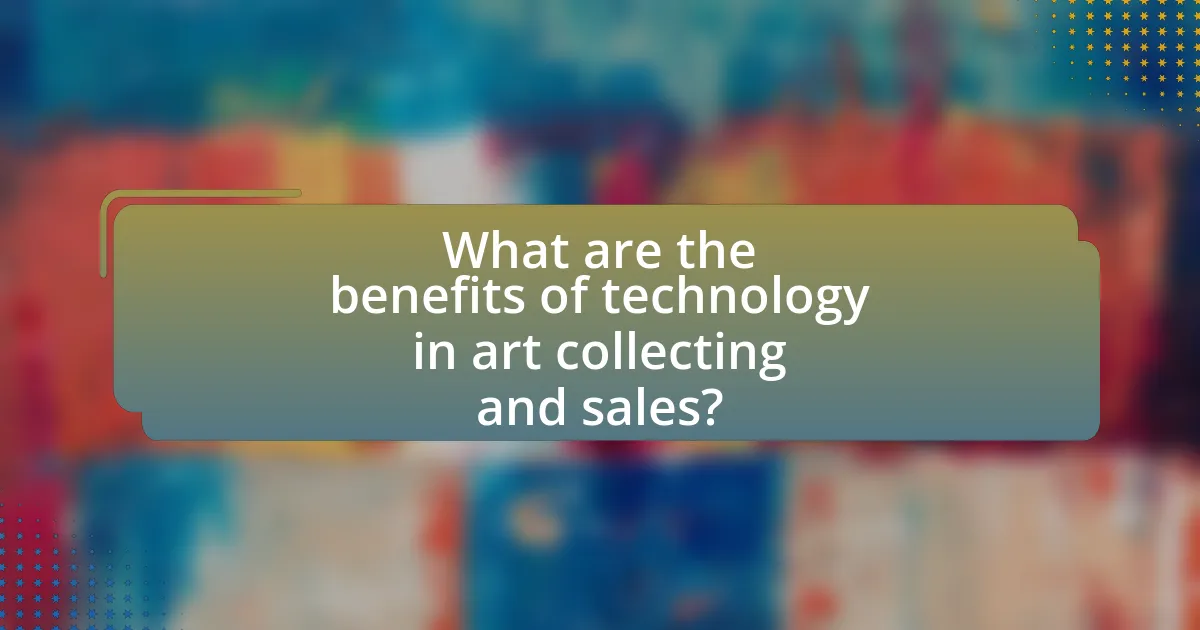
What are the benefits of technology in art collecting and sales?
Technology enhances art collecting and sales by increasing accessibility, improving transparency, and facilitating transactions. Online platforms allow collectors to access a global market, enabling them to discover and purchase artworks from diverse artists and galleries. For instance, platforms like Artsy and Saatchi Art provide extensive catalogs that can be browsed from anywhere, breaking geographical barriers.
Additionally, technology fosters transparency through blockchain, which can verify the provenance of artworks, thus reducing the risk of fraud. A study by Deloitte indicates that 53% of art collectors are more likely to purchase art if they can verify its authenticity through digital means. Furthermore, digital payment systems streamline transactions, making it easier for buyers and sellers to complete sales efficiently.
Overall, technology significantly transforms the art market by making it more accessible, transparent, and efficient.
How does technology enhance accessibility for collectors?
Technology enhances accessibility for collectors by providing online platforms that facilitate the buying, selling, and showcasing of art. These platforms, such as online galleries and auction sites, allow collectors to access a global market, expanding their options beyond local galleries. For instance, a report by Hiscox Online Art Trade Report 2021 indicates that 70% of collectors purchased art online, demonstrating the significant shift towards digital transactions. Additionally, virtual reality and augmented reality technologies enable collectors to experience artworks in immersive environments, making it easier to evaluate pieces before purchase. This technological integration not only broadens the reach for collectors but also streamlines the acquisition process, making art more accessible than ever.
What tools facilitate easier access to art for new collectors?
Online platforms and apps facilitate easier access to art for new collectors by providing a wide range of artworks, transparent pricing, and user-friendly interfaces. Websites like Artsy and Saatchi Art allow collectors to browse diverse collections, connect with artists, and purchase art directly, often featuring detailed descriptions and provenance information. Additionally, virtual reality tools enable immersive experiences, allowing collectors to visualize art in their own spaces before making a purchase. According to a report by Hiscox, 78% of art buyers now use online platforms to discover new artists, highlighting the significant role technology plays in democratizing art access for new collectors.
How does technology democratize the art market?
Technology democratizes the art market by providing broader access to art creation, distribution, and sales platforms. Online galleries and marketplaces, such as Saatchi Art and Artsy, enable artists to showcase their work globally without the need for traditional gatekeepers like galleries or auction houses. This shift has led to a significant increase in the number of artists and collectors participating in the market; for instance, a report by Hiscox Online Art Trade Report 2021 indicated that 70% of online art buyers were new to the art market. Additionally, social media platforms allow artists to build their own audiences and engage directly with potential buyers, further reducing barriers to entry. As a result, technology fosters inclusivity and diversity in the art world, allowing a wider range of voices and perspectives to be represented.
What efficiencies does technology bring to art transactions?
Technology enhances art transactions by streamlining processes, increasing accessibility, and improving transparency. Digital platforms enable buyers and sellers to connect globally, reducing geographical barriers and allowing for a wider market reach. For instance, online auction houses and marketplaces have seen significant growth, with platforms like Artsy and Saatchi Art facilitating millions in sales annually. Additionally, blockchain technology provides secure provenance tracking, ensuring authenticity and reducing fraud, which is crucial in high-value art transactions. According to a report by Hiscox, the online art market reached $4.8 billion in 2021, highlighting the efficiency and growth driven by technology in this sector.
How do digital transactions streamline the buying process?
Digital transactions streamline the buying process by enabling faster and more efficient exchanges of funds and information. They eliminate the need for physical cash or checks, reducing transaction times significantly; for instance, a study by the Federal Reserve indicates that electronic payments can be completed in seconds compared to days for traditional methods. Additionally, digital transactions provide instant confirmation and tracking, enhancing transparency and security for both buyers and sellers. This efficiency not only accelerates the purchasing process but also allows for a broader reach in art collecting, as transactions can occur globally without geographical constraints.
What impact does technology have on pricing transparency?
Technology significantly enhances pricing transparency by enabling real-time access to pricing information and market data. Online platforms and digital marketplaces allow collectors and buyers to compare prices across various artworks and artists instantly, reducing information asymmetry. For instance, platforms like Artsy and Artnet provide comprehensive databases of past sales, auction results, and current listings, which empower buyers to make informed decisions. According to a report by Hiscox, 75% of art buyers now research online before making a purchase, illustrating the shift towards data-driven decision-making in art collecting. This increased access to information fosters a more competitive market, ultimately benefiting consumers through fairer pricing.
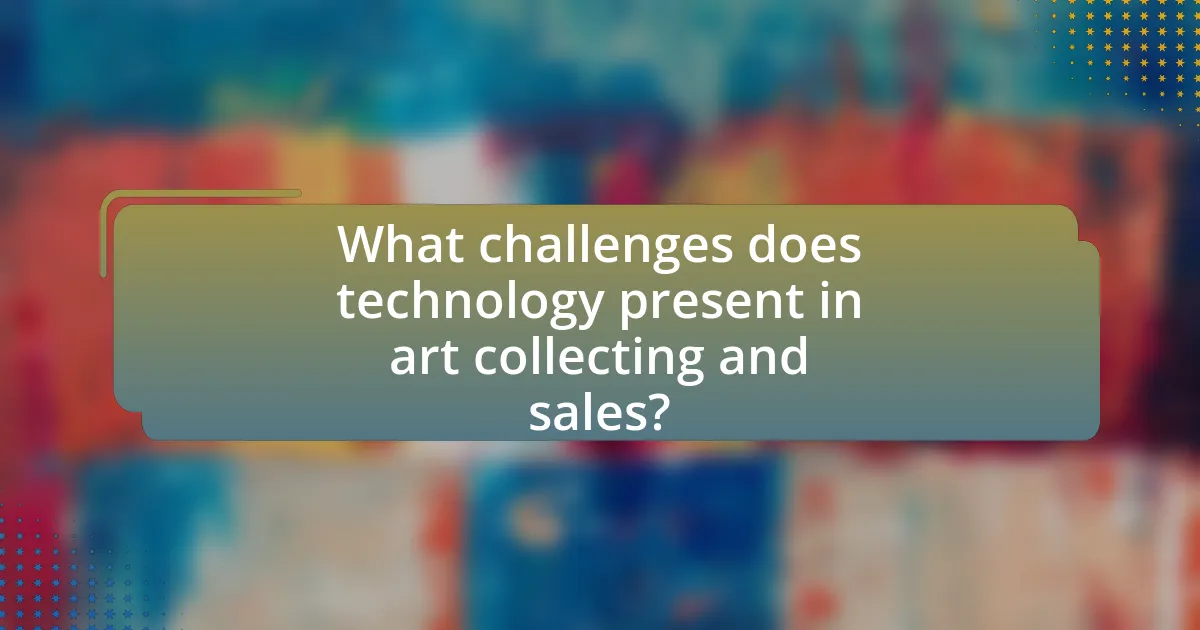
What challenges does technology present in art collecting and sales?
Technology presents several challenges in art collecting and sales, primarily including issues of authenticity, market saturation, and data security. The rise of digital art and NFTs has complicated the verification of original works, leading to concerns about counterfeit pieces and the integrity of ownership. Additionally, the ease of online sales platforms has resulted in an oversaturated market, making it difficult for collectors to discern valuable art from less significant works. Furthermore, the reliance on digital transactions raises significant data security concerns, as personal and financial information can be vulnerable to cyber threats. These challenges highlight the complexities that technology introduces into the art market, necessitating new strategies for collectors and sellers to navigate effectively.
What are the risks associated with online art transactions?
The risks associated with online art transactions include fraud, lack of authenticity verification, and potential for misrepresentation. Fraud can occur through counterfeit artworks or deceptive sellers, leading to financial loss for buyers. The lack of authenticity verification poses a significant risk, as online platforms may not adequately vet the provenance of artworks, resulting in the sale of forgeries. Additionally, misrepresentation can happen when sellers provide misleading descriptions or images of the artwork, which can lead to buyer dissatisfaction and disputes. According to a report by Hiscox, 47% of art buyers expressed concerns about the authenticity of artworks purchased online, highlighting the prevalence of these risks in the digital art market.
How can collectors protect themselves from fraud in digital sales?
Collectors can protect themselves from fraud in digital sales by conducting thorough research on sellers and verifying the authenticity of artworks. This includes checking the seller’s reputation through reviews, ratings, and previous sales history on reputable platforms. Additionally, collectors should request provenance documentation and certificates of authenticity, as these provide proof of an artwork’s legitimacy. According to a report by Hiscox, 47% of art buyers have encountered issues with authenticity, highlighting the importance of due diligence. Utilizing secure payment methods and platforms that offer buyer protection can further mitigate risks associated with fraud in digital transactions.
What issues arise from the lack of physical inspection of art?
The lack of physical inspection of art leads to issues such as misrepresentation of condition, authenticity concerns, and diminished buyer confidence. Without a physical examination, potential buyers cannot accurately assess the artwork’s condition, which may include hidden damages or alterations that are not visible in digital images. This lack of transparency can result in buyers purchasing pieces that do not meet their expectations or that are not as valuable as represented. Furthermore, the inability to verify authenticity through physical inspection increases the risk of fraud, as forgeries may be more easily passed off as genuine. According to a report by the Art Loss Register, approximately 20% of artworks sold online are misrepresented in terms of condition or authenticity, highlighting the significant risks associated with relying solely on digital representations.
How does technology affect the valuation of art?
Technology significantly influences the valuation of art by enhancing accessibility, transparency, and market dynamics. Digital platforms allow broader audiences to discover and purchase art, which can increase demand and subsequently raise prices. For instance, online auctions and galleries have expanded the market reach, enabling artists to sell directly to collectors without traditional intermediaries, thus affecting perceived value. Additionally, blockchain technology provides provenance verification, ensuring authenticity and reducing fraud, which can enhance an artwork’s market value. According to a report by Hiscox Online Art Trade Report 2021, online art sales reached $12.4 billion in 2021, illustrating the substantial impact of technology on art valuation.
What challenges do appraisers face with digital art?
Appraisers face several challenges with digital art, primarily due to its intangible nature and the lack of established valuation standards. Unlike traditional art forms, digital art can be easily replicated, making it difficult to determine originality and authenticity. This challenge is compounded by the rapid evolution of technology, which leads to varying formats and platforms for digital art, further complicating the appraisal process. Additionally, the absence of a comprehensive market history for many digital artworks makes it challenging to establish comparable sales, which are crucial for accurate valuation. These factors contribute to uncertainty in pricing and can hinder the appraiser’s ability to provide reliable assessments.
How does technology influence market trends and valuations?
Technology significantly influences market trends and valuations by enhancing accessibility, enabling data analysis, and facilitating new sales platforms. The rise of online marketplaces and digital galleries allows collectors and artists to reach a global audience, thereby increasing demand and potentially elevating valuations. For instance, the online art market grew to $4.82 billion in 2021, according to the Hiscox Online Art Trade Report, demonstrating how technology expands market reach. Additionally, data analytics tools provide insights into buyer behavior and market dynamics, allowing stakeholders to make informed decisions that can drive valuations upward. Overall, technology reshapes the art market landscape by creating new opportunities and altering traditional valuation methods.
What best practices should collectors follow in the digital age?
Collectors should prioritize digital authentication and provenance verification in the digital age. Utilizing blockchain technology can ensure the authenticity of artworks and track ownership history, which is crucial for maintaining value and trust. Additionally, collectors should engage with online platforms that offer secure transactions and transparent pricing, as these features enhance the buying experience and reduce the risk of fraud. Research indicates that 70% of collectors prefer platforms that provide detailed information about the artwork’s history and condition, reinforcing the importance of informed purchasing decisions. Furthermore, collectors should actively participate in online communities and forums to stay updated on market trends and connect with other collectors, which can lead to valuable insights and opportunities.










